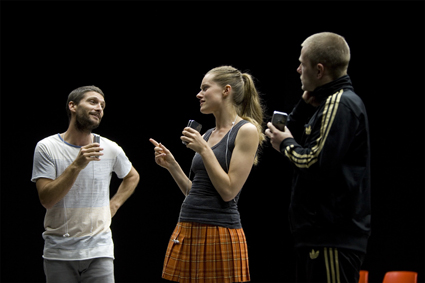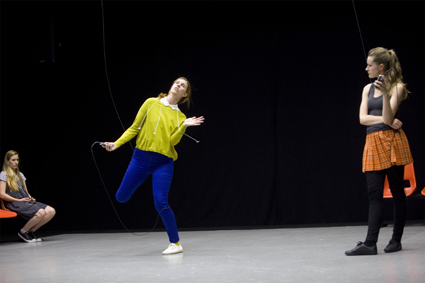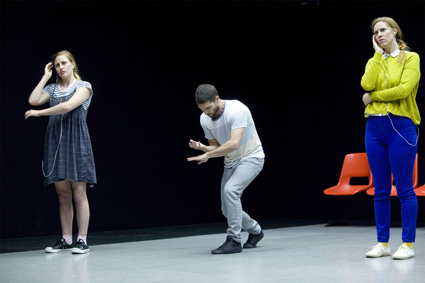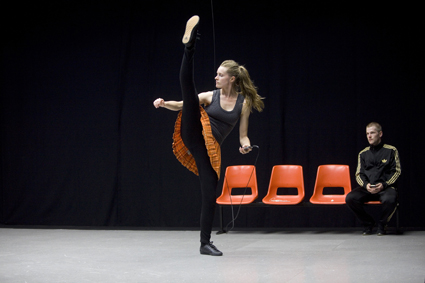old tropes & the new disconnect
carl nilsson-polias: lucy guerin inc & belvoir, conversation piece

Byron Perry, Stephanie Lake, Alisdair Macindoe, Conversation Piece, Lucy Guerin Inc
photo Ponch Hawkes
Byron Perry, Stephanie Lake, Alisdair Macindoe, Conversation Piece, Lucy Guerin Inc
FOUR YEARS AGO, AT DANCE MASSIVE 2009, THE MEAT MARKET IN NORTH MELBOURNE PLAYED HOST TO THE PREMIERE OF LUCY GUERIN’S UNTRAINED. HER LATEST WORK, CONVERSATION PIECE, CAN BE READ AS AN EVOLUTION AND EXTRAPOLATION ON THIS EARLIER WORK.
Untrained placed two professional dancers beside two complete dance novices in an investigation of performativity, purity and, of course, training. Conversation Piece places three professional dancers beside three professional actors in an investigation of performativity, language and modes of communication.
Untrained was restricted to a clinical essence of form, a physical call-and-response, where the authorial voice of Guerin was evident only in the structure (a list of provocations) rather than in the content, which wholly derived from the performers. Conversation Piece operates with a somewhat looser form, where the performers now respond to one another’s provocations, and is leavened with choreographed intermissions that act to reassert Guerin’s voice in proceedings. Guerin also gradually inflects the piece with a unifying tone and a quasi-narrative based around the performers as characters rather than the performers as themselves.
The set for Untrained was simply a grey square marked out by a white line. The set for Conversation Piece is a minimalist suggestion of an anonymous waiting space—a bus terminal, a Centrelink office—with its three sets of four orange chairs echoing those in Shaun Parker’s This Show is About People (2008).
Untrained was an experiment in physical performance unmediated by technology. Conversation Piece is an experiment mediated by iPhones, which do not act as phones, but rather as audio and video recording devices, playback devices and, crucially, as signifiers of the age.

Megan Holloway, Kath Tonkin, Stephanie Lake, Conversation Piece, Lucy Guerin Inc
photo Ponch Hawkes
Megan Holloway, Kath Tonkin, Stephanie Lake, Conversation Piece, Lucy Guerin Inc
What is the value of juxtaposition? When one places a trained body beside an untrained body, does it simply reveal that one can pirouette, the other not? When one places an actor beside a dancer, does it simply reveal that one can speak, the other move? When one places one show beside another, does it similarly reveal only the literal points of difference?
In Untrained, the juxtaposition revealed as much about the audience as it did about the men on stage; what did we find engaging, funny, charming, impressive? It deftly walked the line between a celebration of naivety and experience, without falling into mawkishness or snobbery.
In Conversation Piece, the juxtaposition is more complex and more ambitious. Yes, we are at times invited to witness the gladiatorial struggle between body and voice, as though it were a battle of virtuosity where our laughter or applause determine the victor. But we are also asked to consider how both these forms—how communication itself—is affected by the iPhones’ mediations.

Megan Holloway, Byron Perry, Kath Tonkin, Conversation Piece, Lucy Guerin Inc
photo Ponch Hawkes
Megan Holloway, Byron Perry, Kath Tonkin, Conversation Piece, Lucy Guerin Inc
The work begins with an eight-minute improvised conversation between the three dancers, which is recorded on iPhones. The three actors enter, plug into an iPhone each and listen back to the conversation. Each actor then relays one of the dancers’ words, but stripped of modulation, gestures or appropriate tone. When all laughs are presented as cackles, all words presented with the same intonation and there is no gestural language available, it becoms a spoken text message. Some commentators have begun diagnosing texting-addicted teenagers and 20-somethings as ‘flatliners’—their lack of engagement with the spoken word turning them into the walking dead of verbal communication. In Conversation Piece, the actors bring them alive.
In other respects, Conversation Piece rehashes some very familiar 20th century tropes. The presentation of people linked together on a superficial level of purpose but without any expressive connections—that is to say, people waiting together at a bus terminal—is at least as old as Jean-Paul Sartre and his conceptions of seriality and alterity. So, if philosophers and artists have warned of increasing human disconnectedness since the inception of radio, what more can be said? Perhaps nothing completely new, but Guerin steadily pushes the tone of Conversation Piece into unexpectedly sinister landscapes.

Stephanie Lake, Alisdair Macindoe, Conversation Piece, Lucy Guerin Inc
photo Ponch Hawkes
Stephanie Lake, Alisdair Macindoe, Conversation Piece, Lucy Guerin Inc
At first, we might see a young woman talking irrepressibly in a one-way stream—channelling all three parts of the original recorded conversation. Then, the social one-sidedness might morph into the attempt a young man makes to converse with another man capable only of non-sequiturs. After this, that young man might start to manipulate the other man’s body in an increasingly cruel and unusual manner. Perhaps a woman debases and humiliates another woman in front of everyone. Perhaps a man, uncomfortable in conversation, unsure of himself with others, enacts a slow motion murderous fantasy in a bus terminal. The most important aspect is that all these things happen as monologues.
Conversation Piece is not about the conversation at the beginning of the show. It is about the lack of conversation anywhere else.
–
See also the review of the first season (with largely different cast) of Conversation Piece at Belvoir in Sydney: www.realtimearts.net/
Dance Massive, Arts House: Lucy Guerin Inc & Belvoir, Conversation Piece, choreographer, director Lucy Guerin, performers Megan Holloway, Stephanie Lake, Alisdair Macindoe, Byron Perry, Kath Tonkin, Matthew Whittet, set, costume design Robert Cousins, lighting design Damien Cooper, sound designer, composer Robin Fox; Arts House, Meat Market, March 19-24; http://dancemassive.com.au/






